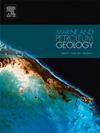Underestimated risks for application of hydraulic fracturing into hydrate exploitation: In the perspective of formation deformation and sand production
IF 3.7
2区 地球科学
Q1 GEOSCIENCES, MULTIDISCIPLINARY
引用次数: 0
Abstract
Hydraulic fracturing in hydrate-bearing formation enhances reservoir permeability, thereby promoting gas production, but simultaneously compromises the mechanical strength integrity of the solid skeleton, amplifying risks of reservoir deformation, seafloor subsidence, and sand production. Despite these challenges, the interplay between hydraulic fracturing and such risks remains inadequately quantified, resulting in underestimation of exploitation risks. In this study, we developed a fully coupled thermal-hydraulic-mechanical-chemical model that incorporates sand production dynamics, validated against experimental data and numerical benchmarks. Using the Shenhu hydrate reservoir as a case study, we evaluated the effects of hydraulic fracturing (characterized by a fracture length of 5 m, a fracture permeability of 1 D, and a damage zone permeability of 50 mD) on long-term gas production, formation deformation, and sand production behaviors. Our analysis reveals that hydraulic fracturing increases cumulative gas production by 57 %, reaching 2.34 × 106 m3 after 1000 days. However, it also triggers significant mechanical degradation: the volumetric strain in the damaged zone exceeds 2.5 %, which exacerbates formation collapse, inducing an additional 7 cm of seafloor subsidence, for a total of 21 cm and intensifying sand production to 903 m3, 2.4 times higher than production without fracturing. Further increases in fracture length beyond 5 m or fracture permeability above 0.1 D yield diminishing returns in gas production but exacerbates sand production. Enhancing the damaged zone's permeability from 25 mD to 75 mD increases gas production by 20 %, but also raises sand production by 49 % and seafloor subsidence by 4 cm.
求助全文
约1分钟内获得全文
求助全文
来源期刊

Marine and Petroleum Geology
地学-地球科学综合
CiteScore
8.80
自引率
14.30%
发文量
475
审稿时长
63 days
期刊介绍:
Marine and Petroleum Geology is the pre-eminent international forum for the exchange of multidisciplinary concepts, interpretations and techniques for all concerned with marine and petroleum geology in industry, government and academia. Rapid bimonthly publication allows early communications of papers or short communications to the geoscience community.
Marine and Petroleum Geology is essential reading for geologists, geophysicists and explorationists in industry, government and academia working in the following areas: marine geology; basin analysis and evaluation; organic geochemistry; reserve/resource estimation; seismic stratigraphy; thermal models of basic evolution; sedimentary geology; continental margins; geophysical interpretation; structural geology/tectonics; formation evaluation techniques; well logging.
 求助内容:
求助内容: 应助结果提醒方式:
应助结果提醒方式:


